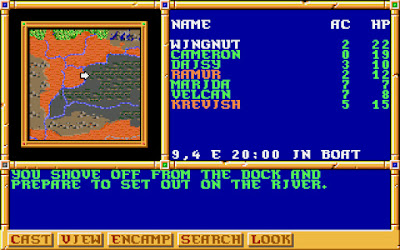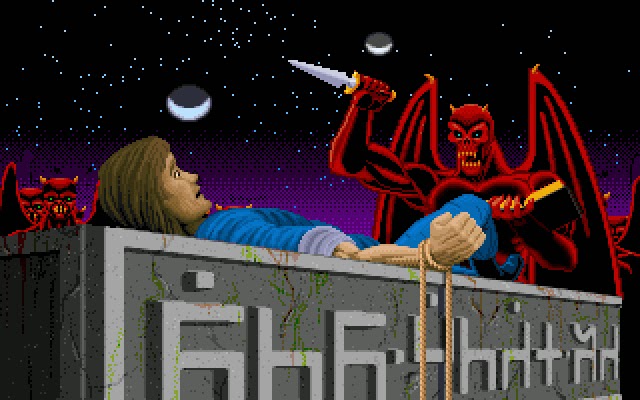Gateway to the Savage Frontier is the first of a two part series of games. It was released for the Commodore 64, Commodore Amiga and PC-DOS in 1991. It's another solid and enjoyable entry in the Gold Box canon.
As always, the first thing to do is to roll-out a party. Like Pool of Radiance the game is set in the Forgotten Realms universe so racial limits apply to non-human characters. Therefore, like Pool of Radiance, most of my party will be human. As I have mentioned before, dice rolls in Gold Box games tend to be on the high side. As a test I kept re-rolling - I got plenty of 18's but none of the rolls in any of the six attributes fell below 10.
Taking up the rear of the party are a female and male magic user, Merida and Velcan. Next up is Ramur, a cleric. Daisy is a half-elf and my only non-human character; I made her a fighter/thief/magic user. The thief class is not racially limited but she will top out as a fighter at level 7 and mage at level 8. As much as I hate role-playing them, and as I have not used one in a Gold Box game before, I made Cameron the hoity-toity, holier than thou, goody two-shoes paladin. Leading the way will be Wingnut, a straightforward, salt of the Earth fighter. All the characters start at level 2.
As usual I started playing this game on the Amiga as it has the edge over the PC version. Things did not go to plan as the game began locking up with certain actions such as fleeing combat and bashing doors. It eventually got bad enough that I couldn't continue and had to play the DOS version. I have played five previous Gold Box games on the Amiga without any issues so my copy is probably corrupt. It does however give me an opportunity to compare the engine on the two platforms.
Firstly, the character creation. Obviously rolling the stats will be the same for both but creating the character icons is a much more laborious process on the PC. You have choose whether you want to change the 1st or 2nd colour, then cycle through the 15 available colours until you find the one you want. The Amiga does it all on one screen making it much simpler, and with 30 colours in the palette I didn't have to compromise as I did with DOS the game.
 |
| The icon screen on the Amiga (right) is infinitely more user friendly. |
With VGA as a graphics option the PC should be able to display better graphics than the Amiga. In reality there is no difference.
 |
| Aside from the blue background on the Amiga, the graphics are virtually identical. |
The audio is streets ahead on the Amiga. The game only plays spot effects and the occasional tune but all are of much better quality on the Commodore machine.
The major annoyance (especially in combat) is having to press 'M' every time you want to move a character. On the Amiga you can press the direction keys and you go. Similarly, at the end of your moves in combat you have to press A(im) then T(arget) to get in a final hit. On the Amiga pressing the direction key will do the same thing.
The only real advantage the DOS version has is the ability to install the game on a hard drive. It is quicker to start the game and there are no noticeable loading times within the game itself. The Amiga game came on three floppy disks and, with two drives supported, you only need to swap disks when saving.
The game begins in the town of Yartar. Having had an uneventful journey escorting a caravan of mithril from Citadel Abdar to Yartar, the party are out on the town spending their well earned gold. During the evening, something is slipped into their food causing them to pass out. In the morning they awake to find all their gold and possessions (including a prized magic sword) have been stolen. They vow to find those responsible and to retrieve the sword.
Yartar is the standard 16 x 16 town containing a weapon shop, training hall, temple, inn and a couple of bars. Each character had a few platinum pieces so I was able to equip them with weapons and armour. The only options available on entering any bar is 'fight' or 'leave' (sounds like a pub I know). With a paladin on the team I would not start an unprovoked fight so I had to choose 'leave'; I just hope I don't miss anything important.
 |
| "I suppose a drink is out of the question?" |
During my exploration I rescued Krevish, a fighter, who was being attacked by some bandits. He took me to his leader who wanted me to deal with a cleric of Bane who is causing disruption in Nesme. Krevish also offered to join the party. He does take his share of the spoils and experience but an extra weapon is always handy. At this point, Ramur was ready to level up but I didn't have anywhere near enough gold to afford the 1,000gp required at the training hall.
Leaving for Nesme brought up the overworld map. Instead of using the cursor keys to move in the direction you want, you have to use the left/right key to change the way the party is facing and the up key to move forward. I guess this ties it in with the movement in the towns/dungeons but it is not very intuitive. On they way we encountered some hill giants who demolished the party before I even got near them - their thrown stones could one-hit-kill most of my characters. Reloading, I paid to journey by boat which was uneventful.
Nesme was another 16 x 16 town with the usual establishments. It has been suffering incursions from Lizard Men and in two parts of the town there was a 'troll problem'. The town was offering a 100gp reward for each troll killed, but from Pool of Radiance experience I knew I would not be powerful enough to face them yet. I did find the Banite Cleric who began burning some papers as I entered the room. After I killed him the remains of a letter said the Banites were intending to foil a Zhentarim plot to take control of the region and that there was a magic user who knew of a way stop them. As the cleric was now dead my quest was revealed - it is up to my party to find the magic user and take on the Zhentarim.
It turned out the wizard is called Amanitas and has gone and got himself captured. As always, the only man who can disrupt the Zhentarim plans is conveniently kept alive long enough to be rescued. He reveals the Zhentarim, led by General Vaalgamon, are seeking four magical statuettes that in times past protected the ancient city of Ascore. We are tasked with finding the statuettes before Vaalgamon.
I will note my thoughts below.....
- The Gold Box engine always give me something to grumble about, not least in this game for the things that have been taken out. Gone are the custom character icons that were present in the Krynn games (at least in the Amiga version). Also gone are the improved graphical effects for spells that were introduced in Death Knights. Finally, the diagonal cursor has also been removed. I used this a lot for movement in combat and I can see absolutely no reason for programming out a feature that has been present since Pool of Radiance.
- Gateway to the Savage Frontier features an overworld map but it is slightly different to those contained in previous Gold Box games. It is now viewed in the 3D window, rather than using most of the screen, and is split into several sections. Navigation is less user friendly in that you have to turn the party in the direction you wish to go then move forward rather than move in the four cardinal directions using the cursor keys. If a town is next to a river, you can travel by boat which offers up less of the long-winded random encounters that take place in the wilderness. I didn't go hunting for side quests in the overworld map despite locations such as the Trollmoors and dangerous Neverwinter Woods.
 |
| The viewing window only shows a portion of the overworld map. |
- I did stumble across two optional side quests. One involved taking a piece of meteorite to a shop in Neverwinter where they could use it to fashion a magical weapon.
- The game has a good range of monsters to fight. One memorable combat takes place in an aquarium which requires a change of normal combat tactics.
 |
| Strangely the Stinking Cloud spell still worked and made the squids cough and nauseous (Amiga screenshot). |
As mentioned above the object of the game is to collect four statuettes.
After each one Amanitas tells you where the next is located. Once you have all four it is time to head to Ascore where the final confrontation takes place.
The end of the Gateway to the Savage Frontier is a change from the Gold Box norm and slightly disappointing. Firstly, you have to go through several fights in the combat view, so there are no opportunities to save the game or rest to recover HP and MP.
In the final room you face General Vaalgamon along with Zhentarim fighters and mages, and several shambling mounds. I had a few attempts at defeating him but could not get close - he is difficult to physically hit, casts powerful spells and is immune to magic. There is however an exit just to the north of where you enter the room and directing a character through there leads to the end of the game (and lots of reading)....






















































